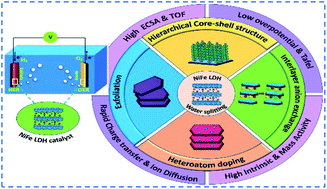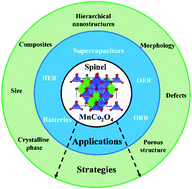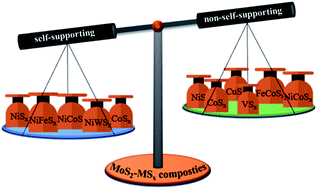Themed collection Editor’s Choice 2023: Advancing electrocatalysts for a sustainable future.

Journal of Materials Chemistry A Editor’s choice collection: Advancing electrocatalysts for a sustainable world
Dr Subrata Kundu introduces a Journal of Materials Chemistry A Editor’s choice collection on electrocatalysis for sustainability.

J. Mater. Chem. A, 2023,11, 22018-22019
https://doi.org/10.1039/D3TA90188B
iR drop correction in electrocatalysis: everything one needs to know!
This perspective details every single aspects of iRu drop correction in controlled-potential electrocatalysis from fundamentals to the best practices.

J. Mater. Chem. A, 2022,10, 9348-9354
https://doi.org/10.1039/D2TA01393B
Immobilization strategies for porphyrin-based molecular catalysts for the electroreduction of CO2
Using homogeneous and heterogeneous metalloporphyrin-based catalysts for electroreduction of CO2 to value-added materials.

J. Mater. Chem. A, 2022,10, 7626-7636
https://doi.org/10.1039/D2TA00876A
Emerging ruthenium single-atom catalysts for the electrocatalytic hydrogen evolution reaction
Synthesis strategies, characterization methods, and various supports for Ru-based single-atom catalysts and their HER performance are reviewed.

J. Mater. Chem. A, 2022,10, 15370-15389
https://doi.org/10.1039/D2TA03860A
Recent progress in water-splitting and supercapacitor electrode materials based on MOF-derived sulfides
Herein, electrocatalysts for water-splitting and supercapacitor electrode materials based on MOF-derived sulfides are reviewed, considering their key multifunctional roles on the path to a more sustainable society.

J. Mater. Chem. A, 2022,10, 430-474
https://doi.org/10.1039/D1TA05927K
Recent progress of MXenes and MXene-based nanomaterials for the electrocatalytic hydrogen evolution reaction
In this review, recent advances in MXenes and MXene-based nanomaterials applied in HER electrocatalysis are overviewed in terms of their synthesis, characterization, functional mechanisms, and HERperformance/optimization.

J. Mater. Chem. A, 2021,9, 6089-6108
https://doi.org/10.1039/D0TA11735H
Recent advances in transition-metal-sulfide-based bifunctional electrocatalysts for overall water splitting
This review summarizes recent advances relating to transition metal sulfide (TMS)-based bifunctional electrocatalysts, providing guidelines for the design and fabrication of TMS-based catalysts for practical application in water electrolysis.

J. Mater. Chem. A, 2021,9, 5320-5363
https://doi.org/10.1039/D0TA12152E
Recent progress in the development of biomass-derived nitrogen-doped porous carbon
Synthesis of biomass-derived N-doped porous carbon for energy storage and catalysis applications is a sustainable and environmentally friendly approach.

J. Mater. Chem. A, 2021,9, 3703-3728
https://doi.org/10.1039/D0TA09706C
Recent advances in highly active nanostructured NiFe LDH catalyst for electrochemical water splitting
The progress in the design strategies and synthetic mechanisms for each class of NiFe LDH electrocatalysts as well as the key trends in structural characterizations in catalyzing the water splitting process are discussed.

J. Mater. Chem. A, 2021,9, 3180-3208
https://doi.org/10.1039/D0TA10712C
Multifunctional spinel MnCo2O4 based materials for energy storage and conversion: a review on emerging trends, recent developments and future perspectives
In this review, electrocatalysts for HER/OER/ORR and energy storage electrode materials based on MnCo2O4 were reviewed considering their key multifunctional role in the way to a more sustainable society.

J. Mater. Chem. A, 2021,9, 3095-3124
https://doi.org/10.1039/D0TA11129E
Interface engineering of transitional metal sulfide–MoS2 heterostructure composites as effective electrocatalysts for water-splitting
Recent progress about transitional metal sulfide–MoS2 heterostructure composites are reviewed based on the view point of interface engineering.

J. Mater. Chem. A, 2021,9, 2070-2092
https://doi.org/10.1039/D0TA10815D
Recent progress of high-entropy materials for energy storage and conversion
This review covers the recent developments in catalysis, water splitting, fuel cells, batteries, supercapacitors, and hydrogen storage enabled by high entropy materials.

J. Mater. Chem. A, 2021,9, 782-823
https://doi.org/10.1039/D0TA09578H
C-, N-Vacancy defect engineered polymeric carbon nitride towards photocatalysis: viewpoints and challenges
As an alluring metal-free polymeric semiconductor material, graphite-like carbon nitride (g-C3N4; abbreviated as GCN) has triggered a new impetus in the field of photocatalysis, mainly favoured from its fascinating physicochemical and photoelectronic structural features.

J. Mater. Chem. A, 2021,9, 111-153
https://doi.org/10.1039/D0TA08384D
Seawater electrocatalysis: activity and selectivity
Seawater electrolysis can be considered the solution to the global energy demand. The current review discusses the recent advancements and limitations related to its practical application for providing clean hydrogen gas.

J. Mater. Chem. A, 2021,9, 74-86
https://doi.org/10.1039/D0TA08709B
A magnetron sputtered Mo3Si thin film: an efficient electrocatalyst for N2 reduction under ambient conditions
Mo3Si is a superior catalyst for electrochemical N2 reduction in 0.1 M Na2SO4, offering a large NH3 yield of 2 × 10−10 mol s−1 cm−2 and a high Faraday efficiency of 6.69% at −0.4 V and −0.3 V vs. a reversible hydrogen electrode, respectively.

J. Mater. Chem. A, 2021,9, 884-888
https://doi.org/10.1039/D0TA11231C
Rational design of bimetallic Rh0.6Ru0.4 nanoalloys for enhanced nitrogen reduction electrocatalysis under mild conditions
As an effective eNRR catalyst, bimetallic RhRu nanoalloys (NAs) with cross-linked curly nanosheets were successfully prepared and exhibited exciting results in the eNRR process.

J. Mater. Chem. A, 2021,9, 259-263
https://doi.org/10.1039/D0TA09099A
Self-powered NH3 synthesis by trifunctional Co2B-based high power density Zn–air batteries
An approach to eliminate the use of external power to drive NH3 synthesis is presented. A trifunctional Co2B catalyst enables high power density ZABs (500 mW cm−2) to drive NH3 synthesis with a production rate of 1.048 mg h−1 mgcat.−1 after 2 h.

J. Mater. Chem. A, 2023,11, 12223-12235
https://doi.org/10.1039/D3TA02178E
Energy-saving hydrogen production by the methanol oxidation reaction coupled with the hydrogen evolution reaction co-catalyzed by a phase separation induced heterostructure
A MOR/HER system comprising a heterostructured NiSe/MoSe2 bifunctional catalyst shows energy-saving hydrogen production, predicting the coordination of electrosynthesis and electrocatalysis for future energy and chemical engineering applications.

J. Mater. Chem. A, 2022,10, 20761-20769
https://doi.org/10.1039/D2TA02955C
Chemical etching induced microporous nickel backbones decorated with metallic Fe@hydroxide nanocatalysts: an efficient and sustainable OER anode toward industrial alkaline water-splitting
An efficient and sustainable gas diffusible OER anode toward industrial alkaline water-splitting is fabricated by simply immersing Ni foam in ethanolic FeCl3 etchant, which produces a microporous Ni backbone decorated with nanocatalysts.

J. Mater. Chem. A, 2022,10, 8989-9000
https://doi.org/10.1039/D1TA10103J
Multi-walled carbon nanotube supported manganese selenide as a highly active bifunctional OER and ORR electrocatalyst
A manganese selenide and multiwalled carbon nanotube-based composite shows promising bifunctional electrocatalytic activity for the oxygen evolution and oxygen reduction reactions with superior stability and lower overpotential for both OER and ORR.

J. Mater. Chem. A, 2022,10, 6772-6784
https://doi.org/10.1039/D1TA09864K
Machine learning assisted high-throughput screening of transition metal single atom based superb hydrogen evolution electrocatalysts
Carbon-based transition metal (TM) single-atom catalysts (SACs) have shown great potential toward electrochemical water splitting and H2 production.

J. Mater. Chem. A, 2022,10, 6679-6689
https://doi.org/10.1039/D1TA09878K
Platinum-complexed phosphorous-doped carbon nitride for electrocatalytic hydrogen evolution
Platinum is atomically dispersed within P-doped C3N4 forming Pt–N/P/Cl coordination interactions, and exhibits markedly enhanced electrocatalytic activity towards the hydrogen evolution reaction in acidic media, as compared to the P-free counterpart.

J. Mater. Chem. A, 2022,10, 5962-5970
https://doi.org/10.1039/D1TA06240A
Remarkable COx tolerance of Ni3+ active species in a Ni2O3 catalyst for sustained electrochemical urea oxidation
Ni2O3 exhibits a high current density for urea electro-oxidation due to efficient interaction of NiO(OH) active catalyst species with reactants compared to the as-synthesized NiO and also shows sustained UOR facilitated by better COx tolerance.

J. Mater. Chem. A, 2022,10, 4209-4221
https://doi.org/10.1039/D1TA05753G
Oxygen vacancy enriched NiMoO4 nanorods via microwave heating: a promising highly stable electrocatalyst for total water splitting
Vacancy enriched NiMoO4(Vo) nanorods have been synthesized by utilizing microwave heating. The oxygen vacancy has bought an excellent OER/HER activity and to reach 10 mA cm−2, NiMoO4(Vo) as anode and cathode just required 360 mV as overpotential.

J. Mater. Chem. A, 2021,9, 11691-11704
https://doi.org/10.1039/D1TA02165F
Mass transport-enhanced electrodeposition of Ni–S–P–O films on nickel foam for electrochemical water splitting
A reproducible and efficient electrodeposition method in a 3D-printed flow cell is used to synthesize high-quality Ni–S–P–O films on nickel foam for overall water splitting.

J. Mater. Chem. A, 2021,9, 7736-7749
https://doi.org/10.1039/D0TA12097A
Mo2B2 MBene-supported single-atom catalysts as bifunctional HER/OER and OER/ORR electrocatalysts
Ni@Mo2B2 can be used as a HER/OER bifunctional electrocatalyst while Cu@Mo2B2 can be used as an OER/ORR bifunctional electrocatalyst.

J. Mater. Chem. A, 2021,9, 433-441
https://doi.org/10.1039/D0TA08630D
About this collection
To celebrate our fantastic Associate Editors and our wider Indian community of authors and readers, we would like to present this Editors Choice collection curated by Journal of Materials Chemistry A and Materials Advances associate editor, Dr Subrata Kundu.
Dr Kundu has curated this collection based on advancing electrocatalysts for a sustainable future. The collection includes Dr Kundu’s favourite papers and reviews that have been published in Journal of Materials Chemistry A over the past 3 years.
Dr. Kundu and his co-workers are working in the forefront area of Materials Sciences with emphasis on energy, environment, catalysis and electrocatalysis fields.